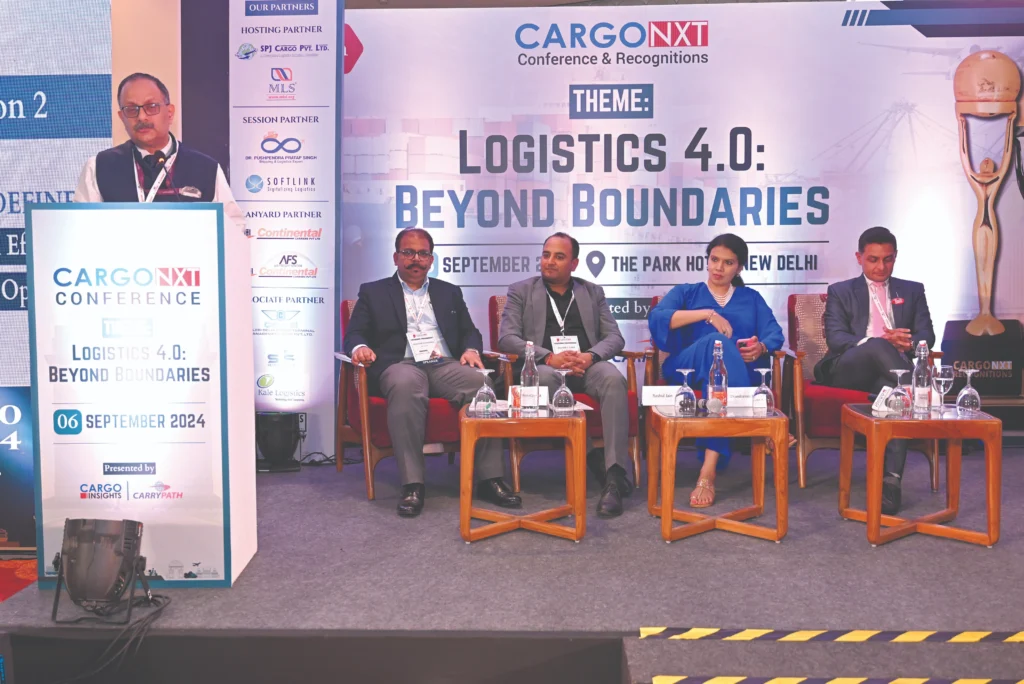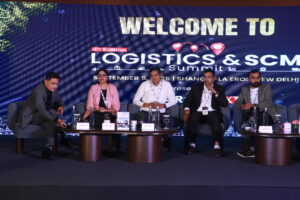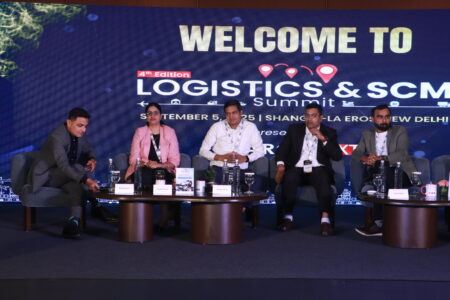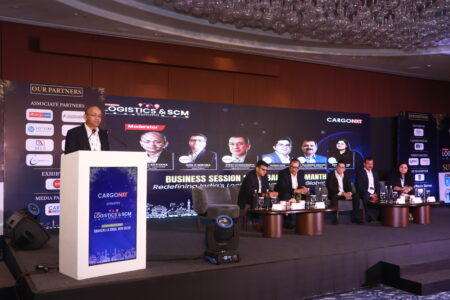In a transformative session on B2B logistics, industry experts will share insights on enhancing supply chain efficiency and cold chain operations, focussing on innovative strategies that redefine logistics landscapes and foster operational excellence.

The business session titled “B2B Logistics Redefined: Enhancing Supply Chain Efficiency and Cold Chain Operations” delved into cutting-edge strategies for optimising logistics in the B2B sector. Moderated by Keku Bomi Gazder, MD & CEO of Aviapro Logistic Services, this session featured a distinguished panel of speakers, including Bharat Kumar Sawnani, Corporate Director, Strategies, G.D. Foods Mfg. (India); Chandrakala Bobba, Director, Bobba Group; Rashul Jain, Global Practice Head, Logistics & Rail, Tech Mahindra; and Mayur Chhabra, Head of Supply Chain (Paints & White Cement division), JK Cement, who shared their expertise on integrated logistics, temperature-controlled operations, and the impact of micro-fulfilment centres on the industry.
Cold chain precision for zero failures

“The importance of cold chain logistics cannot be overstated, especially in the pharmaceutical and agribusiness sectors. Our objective during the vaccine distribution was clear: zero deaths due to delivery failures. We must ensure flawless execution in storage and handling. I look forward to engaging with our panel of experts on the innovative strategies that are shaping our industry.”
~ Keku Bomi Gazder, MD & CEO of Aviapro Logistic Services
From quick commerce to cold chain sustainability

“Logistics is playing an increasingly critical role in today’s business landscape. For example, the $5 billion valuation of Zepto is entirely reliant on efficient logistics. Time is of the essence for consumers, and they expect rapid delivery. Quick Commerce is now even competing with giants like Amazon and Flipkart. In the near future, you’ll be able to order a luxury watch and have it delivered in just 15 minutes! This industry, currently valued at around $3 billion, is growing rapidly, with a projected gross merchandise value increase of 77%. Meanwhile, e-commerce itself is already a $60 billion industry. Companies like Zepto, Swiggy, and Blinkit are expected to reach a combined $10 billion in gross merchandise value soon, all thanks to logistics.
Now, let’s turn our attention to food waste. India loses a staggering amount of food—about 70 million tons every year, amounting to ₹1 lakh crore in losses. Around 40% of perishables never make it from farm to fork, primarily due to inefficient cold chain systems. Although the cold chain industry is valued at $20 billion, it has significant room to grow if we are to reduce food loss.
India ranks 38th out of 139 countries in logistics efficiency, which is a major improvement, but we still lag far behind the leaders, such as Germany.
At G.D. Foods, we focus on the following three strategies:
- Infrastructure Development: While there are cold chain units across India, they are largely concentrated in places like Bengal, Uttar Pradesh, and Maharashtra. The northeast and southern regions still lack sufficient cold chain infrastructure. We also need greater penetration into rural areas. While public-private partnerships and government initiatives like Yojanas are helping, we are still far from where we need to be.
- Integration of IoT: Real-time monitoring of temperature, humidity, and other critical conditions is essential. This kind of real-time data is crucial to maintaining the integrity of cold chain logistics.
- Sustainability: Companies are moving away from Freon-based refrigeration systems, which have a global warming potential (GWP) 15,000 times greater than carbon dioxide. We are transitioning to greener alternatives like ammonia, which has a GWP of zero, and carbon dioxide, which, while still toxic in some respects, is much more sustainable. Shifting to these cleaner technologies is critical for reducing our environmental impact.
Additionally, automated stacking and racking systems, like those used by NinjaCart, are improving logistics efficiency.
It’s around 30–35%. For instance, in food supply chains, especially with perishable goods like tomatoes, spoilage can be a significant issue if there isn’t an efficient supply chain in place from the farm to the storage facilities. While there are technologies like cold chain solutions, they are expensive and not always viable in remote areas where many farms are located. We’ve also seen advancements in retort technologies, which can preserve food at room temperature for longer periods, reducing reliance on cold chains.
Do we have the data to understand where the industry is going and the trends? Absolutely. But do we have the courage to act on it? That’s the real question. Many organisations have the foresight, but taking action involves risks and costs. As consumers, we often say one thing but act differently. For instance, post-COVID, 67% of Indians claim to prioritise health and wellness, but we are still the diabetes capital of the world. This contradiction extends to infrastructure as well. Many companies talk about being ‘future-ready,’ but few have the courage to invest in the infrastructure required for that future, especially if there is uncertainty about demand.”
Blurb: Do we have the data to understand where the industry is going and the trends? Absolutely. But do we have the courage to act on it? That’s the real question.
~ Bharat Kumar Sawnani, Corporate Director, Strategies, G.D. Foods Mfg. (India)
Balancing cost and sustainability

“Clients do enquire about our sustainability initiatives when we discuss what we bring to the table and what they are looking for. However, this is not typically the starting point of the conversation. The initial focus is usually on cost, and environmental considerations follow later. At Bobba Group, we emphasize our solar initiatives—we are completely solar-powered—and also highlight other green elements like rainwater recycling and landscape elements in our micro-fulfillment centers. While cost remains the priority for most clients, sustainability is certainly a factor they evaluate as part of the overall offering.
As the demand at the airport grows, we are seeing the emergence of micro-fulfillment centers and micro-cold chains in proximity to airports, which serve air export and import needs. As much as airports can expand, there is a limit to how much they can grow. Trade continues regardless, and when airports become congested, these strategically located micro-centers and cold chains help ease the load. I have heard similar concerns from my colleagues in the industry, and we resonate with that. As CTOs, we’ve seen peak hours and off-peak hours that create these bottlenecks.”
~ Chandrakala Bobba, Director, Bobba Group
Data-driven logistics: Optimizing efficiency with AI & IoT

“Currently, when we talk about logistics, it’s not just about the mode of transportation. It’s about transportation as a whole, whether it’s bulk cargo, containerised, or unitized. Logistics, or the supply chain in broader terms, is more about how efficiently you deliver cargo at every leg and node. At Tech Mahindra, we’ve been offering integrated multimodal logistics solutions, covering all modes—air, sea, road, and rail—where warehouses or hubs act as nodes.
Logistics is no longer just a ‘milking cow’; it has become an enabler for sales. Companies now use logistics as a tool to enhance their sales. Many organisations face challenges with data, especially after COVID. Many clients have plenty of data but don’t know what to do with it—whether it’s structured or unstructured.
We typically propose a four-step transformation plan to leverage data effectively:
- Create Data: Using IoT, sensors, or other devices to gather data from equipment, like GPS-enabled containers.
- Connect Data: Connecting data from the point of creation to the point of consumption in real-time or near real-time, leveraging technologies like 4G and 5G.
- Data Pipelining: modelling the data to ensure it’s structured properly, which is critical for managing vast networks.
- Leverage AI/ML: Applying AI and ML to optimise operations, reduce inefficiencies, lower costs, and improve key performance indicators (KPIs) across finance, operations, marketing, and customer satisfaction.
This transformation plan helps organisations turn their data into actionable KPIs.”
Blurb: Logistics is no longer just a ‘milking cow’; it has become an enabler for sales
Logistics in Cement: Driving innovation and cost efficiency

“The cement sector is indeed a logistics-heavy industry, especially when it comes to white cement and wall putty, which needs to be shipped to far-flung areas. For grey cement, there are multiple plants close to customers, supplying within a radius of 300 to 400 kilometres. But for white cement and wall putty, we transport material over distances of up to 3,000 kilometres.
Logistics costs make up about 16 to 17 percent of the product cost, from the factory to the depot, including last-mile delivery. For well-established paint companies, such as Asian Paints, logistics costs are about 7.5 to 8 percent of the product revenue. However, for new players in the industry, it can be between 12 and 14 percent, which includes fixed costs, warehousing, and last-mile delivery.
There’s often resistance when talking about cutting manufacturing costs, as the supply chain is viewed as the weakest link—a milking cow that can always give more. But after COVID, there’s been a shift in perception. Supply chain professionals are now being recognised, and the importance of supply chains has been highlighted.
Innovation is key. We’ve started using multimodal transport systems. One challenge we faced was the lack of visibility in the railway network. We had no idea where our shipments were, which made planning difficult. So, we partnered with a U.S.-based company and developed GPS-enabled tracking devices with solar panels for our containers. This allows us to track shipments in real time, even over long distances.
Our partners were often surprised by how we had better visibility than they did. It’s all about finding innovative solutions and convincing the board that the ROI is there.”
~ Mayur Chhabra, Head of Supply Chain (Paints & White Cement division), JK Cement
CONCLUSION
The session on “B2B Logistics Redefined: Strategies for a Resilient Supply Chain” concluded with a strong emphasis on the need for innovation and integration of technology in logistics practices. Participants recognised that enhancing cold chain operations and adopting collaborative strategies are essential for addressing current challenges. The discussions highlighted the importance of creating a more resilient and responsive supply chain landscape to meet the evolving demands of the market. Overall, the session underscored a collective commitment to transforming logistics practices for future success.











